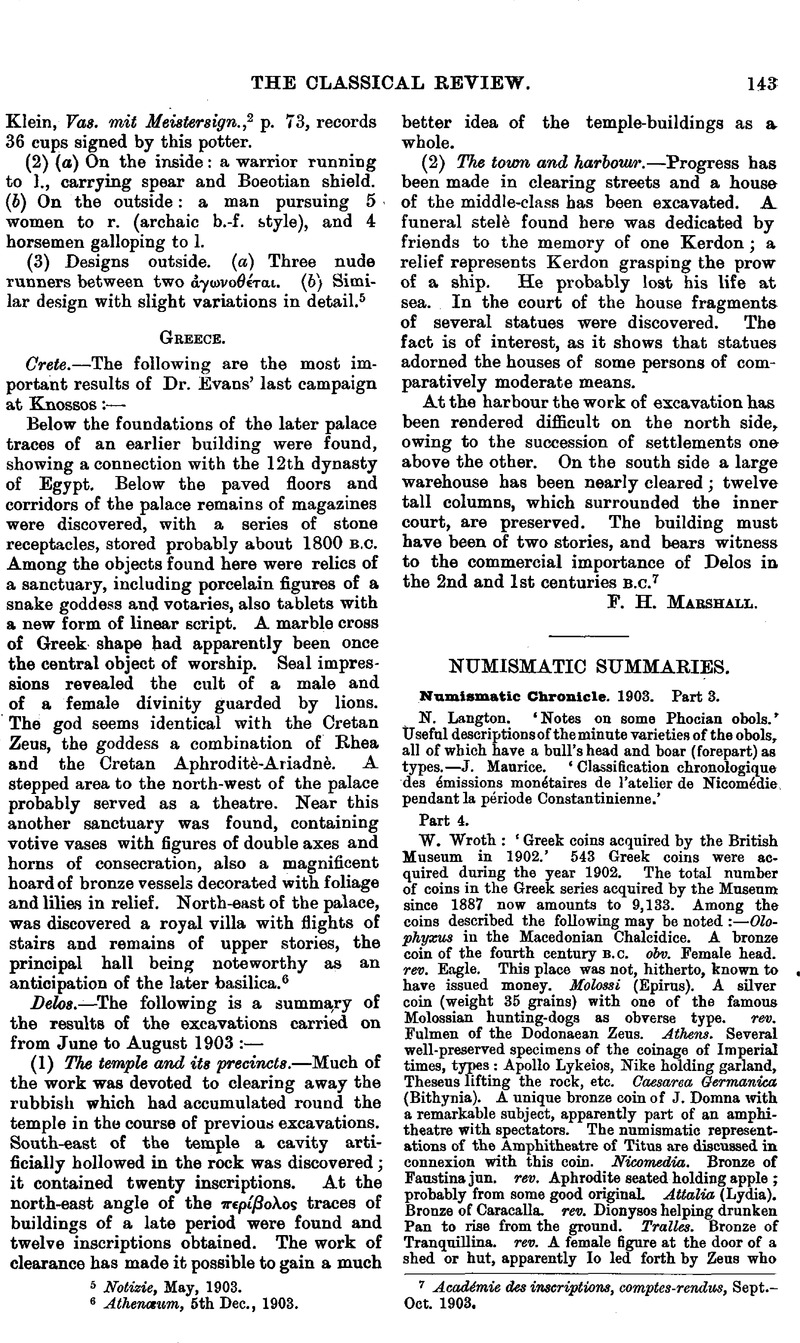No CrossRef data available.
Article contents
Archaeology
Published online by Cambridge University Press: 27 October 2009
Abstract

- Type
- Other
- Information
- Copyright
- Copyright © The Classical Association 1904
References
page 133 note 1 Several causes, none of them connected with the editing of this Review, have led to the regretable postponement of the publication of these notes taken last summer while the exhibition was open.—C. W.
page 135 note 1 Cf. Michaelis, J.H.S. vol. viii. p. 324 seq., PI. LXXX.
page 135 note 2 Conze, , Antike Denkm. p. 30, PL XLIGoogle Scholar.
page 136 note 1 O. Rayet, Mon. Ant. PI. 53; Reinach, Répertoire, etc., ii. p. 371, 4.
page 136 note 2 J.H.S. xxi. p. 215.
page 136 note 3 Intermezzi, p. 5 and p. 11.
page 137 note 1 Collignon, Sc. Gr. J. PI V.
page 137 note 2 Ibid. p. 313.
page 137 note 3 See J.H.S. i. (1880), pp. 168–201, and ii. pp. 332–351; and Essays on the Art of Pheidias, pp. 323 seq.
page 137 note 4 Prof. Vaglieri gives a long summary of this report in the Bullettino Comunale, 1903, pp. 252–271. The illustrations used in the report in the Notinie degli Scavi are largely used here: and individuals or libraries who subscribe to both periodicals may be pardoned for wishing that the contents of the two were rather more independent of one another, if they are both to continue a separate existence (cf. C.R. 1903, p. 329). The validity of Prof. Vaglieri's objection to the title of Comm. Boni's second report (Sepolcreto del Septimontium preromuleo) is doubtful.
page 137 note 6 In mentioning the discovery in C.R. 1902, p. 285, I incorrectly called it a temb ‘a fossa’ (in a. rectangular trench) whereas I should have said ‘a pozzo’ (in a circular shaft), these being the two main classes, here as elsewhere (C.R. 1903, p. 328). My excuse must be that in the official account the hole is spoken of as ‘una fossa o pozzetto scavato nel terreno’ a confusion which destroys the distinction entirely.
page 139 note 1 I take this to be the case from the existence in them of many holes cut in their upper surfaces as if to take the ends of metal bars.
page 140 note 1 The possibility of this is denied by Hülsen, Neue Jahrbücher, 1904, p. 37: and this is the most serious objection to the identification.
page 140 note 2 0. Richter, Beiträge zur römischen Topographie, II., Die Römische Rednerbühne, Berlin, 1903.
page 140 note 3 The curve is really only one-sixth of a circle with a radius of about 78 feet.
page 140 note 4 The emperor represented on these reliefs has been variously conjectured to be Domitian, Trajan, or Hadrian: but there is strong probability that we should identify him with Trajan.
page 140 note 5 From the presence of chips of black marble beneath the level of the latest Republican pavement, Prof. Studniczka infers that the niger lapis was originally laid in connexion with this earlier travertine pavement of the Comitium, which is orientated (in correspondence with the Republican. Curia) with the points of the compass (C.B. 1900, p. 237).
page 142 note 1 Notizie degli Scavi, June, 1903.
page 142 note 2 Bull, delta Comm. Arch. 1903 (3).
page 142 note 3 Notizie degli Scavi, April, 1903.
page 142 note 4 Ibid. Cf. also Bull, della Comm. Arch. 1903, p. 306
page 143 note 5 Notizie, May, 1903.
page 143 note 6 Athenaeum, 5th Dec, 1903.
page 143 note 7 Académie des inscriptions, comptes-rendus, Sept.- Oct. 1903.


